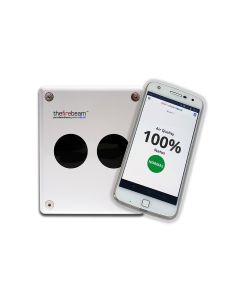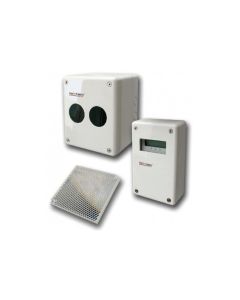We use cookies to make your experience better. To comply with the new e-Privacy directive, we need to ask for your consent to set the cookies. Learn more.
Over 30 Years Experience
We get it right, first time, every time!
Collect from our Trade Counter
Monday to Friday 8.30am - 5pm
Fast Delivery TIMES
Orders Dispatched Same Day*
Conventional Beam Detectors
Conventional beam detectors are a critical asset in any fire protection system designed for large, open spaces.
By offering wide-ranging smoke detection with fewer devices, these detectors provide both a practical and economical solution for facilities that require early warning and reliable fire protection. The coverage capabilities, ease of installation, and low maintenance demands of conventional beam detectors make them an ideal choice for warehouses, auditoriums, shopping centres, and other high-ceilinged spaces. With Firesense’s high-quality range of conventional beam detectors, you can ensure that your building is protected with robust, reliable, and compliant fire detection technology. Our team of experts is here to help you design a customised fire protection solution that meets your building’s specific needs, ensuring peace of mind and enhanced safety for all occupants
Conventional beam detectors are an essential part of fire detection systems, especially in environments with high ceilings and large, open spaces where traditional point detectors may not provide adequate coverage. These detectors work by projecting a beam of infrared light across a designated area. When smoke or particulate matter interrupts this beam, the detector senses a reduction in the light signal and triggers an alarm. Conventional beam detectors are widely used in spaces like warehouses, atriums, gymnasiums, and industrial facilities, where early detection is crucial and where smoke may not reach ceiling-mounted detectors quickly enough for timely alerting.
At Firesense, we offer a range of high-quality conventional beam detectors designed to deliver reliable and effective fire detection in challenging environments. These detectors are manufactured to meet stringent UK and international fire safety standards, ensuring dependable performance and compliance with safety regulations. Conventional beam detectors provide a cost-effective solution for large spaces, as they cover extensive areas with fewer devices, reducing both installation complexity and maintenance demands.
A conventional beam detector operates by projecting a beam of light, typically infrared, between a transmitter and a receiver or a reflective surface. When the beam path is clear, the detector remains in standby mode. However, when smoke or particulate matter disrupts the beam, the detector senses the change in light intensity and sends a signal to the conventional fire alarm control panel, indicating an alarm. Since conventional systems work on a zonal basis, the control panel identifies the zone in which the beam detector is located, allowing emergency responders to know the general area where the fire or smoke has been detected.
The design of conventional beam detectors allows them to cover large areas—often up to 100 metres—making them ideal for buildings with wide-open spaces. Traditional point detectors are less effective in these environments because smoke can dissipate or take longer to reach ceiling-mounted sensors. Beam detectors, on the other hand, can detect smoke quickly and accurately across a wide expanse, providing critical early warning in spaces where fire could spread rapidly.
One of the key advantages of conventional beam detectors is their versatility and adaptability to different environments. These detectors are often mounted on walls or beams, positioned high above the ground to monitor large areas. This placement not only provides broad coverage but also helps minimise interference from day-to-day activities within the monitored space. Additionally, many beam detectors come with adjustable sensitivity settings, allowing them to be fine-tuned for specific conditions. In dusty or humid environments, for example, the sensitivity can be adjusted to reduce false alarms while still providing effective fire detection.
Conventional beam detectors are particularly valuable in buildings with high ceilings, where smoke may rise slowly or dissipate before reaching traditional detectors. Spaces like shopping centres, sports halls, auditoriums, and industrial facilities benefit greatly from beam detectors, as they provide rapid, wide-ranging coverage with minimal equipment. By reducing the number of detectors needed, beam detectors offer both a practical and economical solution for fire protection in large open areas.
Another benefit of conventional beam detectors is their ease of installation and maintenance. Since they require fewer devices to cover expansive areas, beam detectors reduce wiring and installation time, saving on labour costs. Maintenance is also simpler, as fewer devices need to be inspected and serviced. Some beam detectors are equipped with features like self-alignment or automatic calibration, which help maintain optimal alignment between the transmitter and receiver. These features reduce the need for manual adjustments, making it easier to keep the system functioning correctly over time.
Conventional beam detectors also include fault-monitoring capabilities, allowing them to communicate issues like alignment problems, blockages, or wiring faults to the fire alarm control panel. This feature is essential in maintaining system reliability, as it allows maintenance teams to address potential issues before they compromise the detector’s functionality. By monitoring their own status and reporting faults, conventional beam detectors contribute to proactive system management, ensuring that the system remains in optimal working condition.
At Firesense, we provide beam detectors from reputable manufacturers known for their quality and reliability. Our team understands the unique challenges associated with protecting large open spaces, and we work closely with clients to ensure that each system is tailored to the specific requirements of their facility. From product selection and installation advice to post-installation support, we are committed to helping our clients achieve comprehensive fire protection for their buildings.
Choosing Firesense for your conventional beam detector needs means benefiting from our extensive experience and dedication to fire safety. We offer guidance on selecting the right type and model of beam detector, ensuring that each device is strategically positioned for maximum coverage and performance. Our after-sales support includes maintenance advice and access to certified technicians for regular system checks, calibration, and troubleshooting, helping to keep your beam detectors fully operational and compliant.


